15 Famous Classical Paintings Influenced by Greek Mythology
🏛️🏺🔱 Ever wondered where to find the best and most famous classical Renaissance and Baroque paintings that were inspired by Ancient Greek Myths? Here is a list of 15 famous paintings, where they're currently being exhibited, and a description of the Greek Mythology that inspired them 🔱🏺🏛️

Greek mythology has managed to captivate, inspire, and be the Muse for creative minds and storytellers for centuries.
And with its grand tales of heroism & tragedy within a world of Gods, Goddesses, Monsters and mortals, it will no doubt continue to inspire us for centuries more.
It's one thing to know about the myths, and it's another to see them visualised/immortalised by talented artists throughout the glorious Renaissance and Baroque art history movements throughout the years.
So if you can go and see these paintings in real life, definitely don't pass up the opportunity! Their magnificence and grandeur are sure to please all lovers of art and mythology out there.
The Gods of Olympus are a brutal bunch, so before you scroll down any further, be warned that the majority of the paintings depict images of nudity and/or gore (if you are underage, then please seek parental guidance!).
(Please also note that the whereabouts of the paintings are subject to change, but are correct as of writing this blog post. It will be your responsibility to make sure that the painting you wish to see is still on exhibit before you travel.)
So without further ado, here is a list of the greatest classical Renaissance and Baroque art paintings depicting famous Greek Myths. And, where you can currently find them on display.
The Birth of Venus

Painted by: Sandro Botticelli
Dates back to: 1486
Where to see it: Uffizi Gallery, Florence, Italy
The Mythology of Venus (Roman equivalent to Aphrodite) being depicted:
Despite this painting being of Roman Mythology, I couldn't not include it! (Especially with how the Romans basically copied and rebranded Greek Mythology).
Here we see Venus (Goddess of Love, Beauty, and Fertility) being born from the sea with effortless beauty and grace. You'd never think that she was born just moments ago from the blood and semen of a primordial God's castrated nether region falling into the Sea. That primordial God was Uranus (who is the personification of the Sky) and better yet, it was his son Saturn (God of Agriculture and Time) that did the castrating. Luckily, you can't see that happening here. But you can see Favonius (God of the West Wing and Spring) carrying Flora (Goddess/Nymph of Flowers and Spring breeze) as they blow Venus to the shore of Cyprus where one of the Horae (Goddesses of the Seasons) awaits to drape a luxurious floral robe around her.
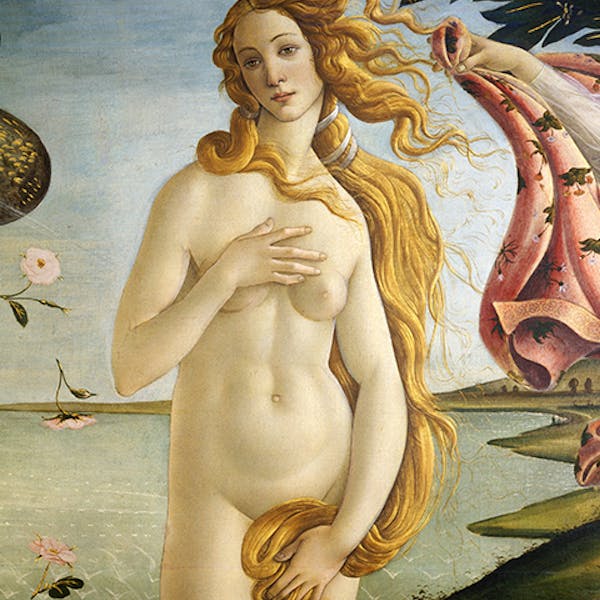
Medusa

Painted by: Michelangelo Merisi da Caravaggio
Dates Back to: 1597
Where to see it: Uffizi Gallery, Florence, Italy
The Mythology of Medusa being depicted:
If you know the story behind why Medusa was turned into a Gorgon, it makes this painting even more horrifying than it already is. Cursed with a hideous snake-like appearance and the ability to turn living beings into stone if they dare make eye contact with her, Medusa has been beheaded by the demi-God Perseus on his quest to save his mother from the tyrannical King Polydectes. From her spilt blood, Pegasus and Chrysaor were born.
Perseus went on to save Andromeda (Princess/daughter of King Cepheus of Aetheopia) by using Medusa's severed head to turn Cetus (a Sea Monster sent by Poseidon) to stone. Eventually, Perseus offers Medusa's head to Athena (Goddess of Wisdom, War Strategy, and Crafts) who places the severed head on her shield, which I like to think is why Caravaggio painted his depiction of Medusa on a circular canvas.
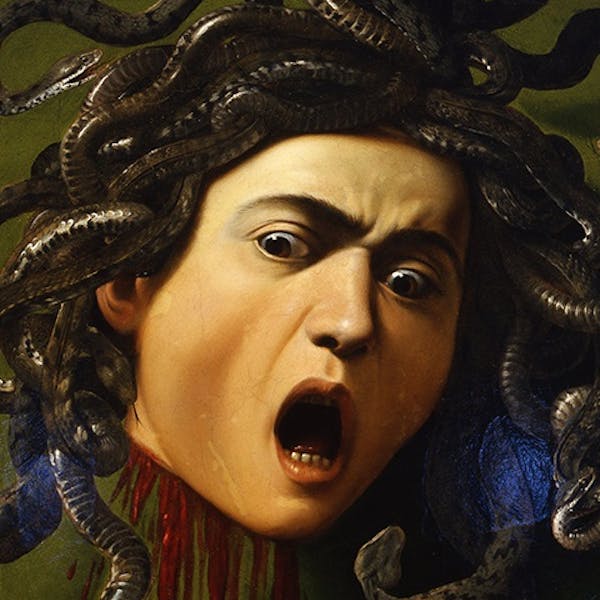
Narcissus

Painted by: Michelangelo Merisi da Caravaggio
Dates back to: 1599
Where to see it: Galleria Corsini, Rome, Italy
The Mythology of Narcissus being depicted:
Narcissus (son of the River God, Cephissus) was a man so beautiful, and only capable of loving himself. One day, he saw his reflection in a pool of water while trying to drink from it, and he could not take his eyes away. And so he stayed and never left. Slowly, he started to become less of himself and wilted into the shape of a Narcissus flower, forever watching his/its reflection by the pool of water.
Discovering his reflection may have been a curse imposed by Nemesis (Goddess of Divine Retribution and Revenge) who learnt of how Narcissus' unkind rejection of Echo's (an Oread/Mountain Nymph) adoration for him had caused her to fade away into, well, an echo.

Three Graces

Painted by: Raphael
Dates back to: 1505
Where to see it: Musée Condé in Chantilly, Oise, France
The Mythology of the Three Graces being depicted:
The Three Graces were the delightful daughters of Zeus (King of Mount Olympus/God of the Sky) and Eurynome (Oceanid/Goddess of Water Meadows and Pasturelands) who were described as being able to bestow gifts of charm, beauty and creativity on to mortals. It's unknown who is who in Raphael's painting, but they are Aglaea (elegance), Euphrosyne (joy) and Thalia (youthful beauty). They will often frequent festivities held by the Gods, and are closely associated with Aphrodite, the Muses, Apollo, and Dionysus.
The Garden of the Hesperides

Painted by: Frederic Leighton
Dates back to: 1892
Where to see it: Lady Lever Art Gallery, Liverpool, UK
The Mythology of the Hesperides being depicted:
The Hesperides (daughters of the Titan Atlas/Nymphs of the Evening and the Golden Light of Sunsets) live within the confines of a garden near the Atlas mountains in Africa. Here, you can find Hera's (Queen of Mount Olympus/Goddess of Marriage, Women, and Childbirth) Orchard where the trees, gifted by Gaia (a primordial Goddess/the personification of the Sky/Hera's grandmother) on her wedding day to Zeus. And it can fruit Golden Apples that grant anyone who eats them the gift of Immortality.
Fearing that the Hesperides would not have the might to protect her Orchard, she placed Ladon, a serpent-like dragon with a hundred heads that never slept, in the garden to protect the Golden Apple tree - he is represented here by the giant Anaconda intertwining itself around the Golden Apple tree and the Hesperides.
Despite this, there have been two well-known tales where some of the Golden Apples have been stolen. There was Hercules who tricked Atlas into stealing them for him while he held up the Heavens - this was so that he could complete one of his 12 Labours. And there was also Eris (Goddess of Discord and Strife) who stole an apple - famously known as the Apple of Discord - wrote "to the fairest' on it, and threw it amongst the Goddesses attending a wedding she was not invited to. This catastrophically led to the events of the Trojan War.
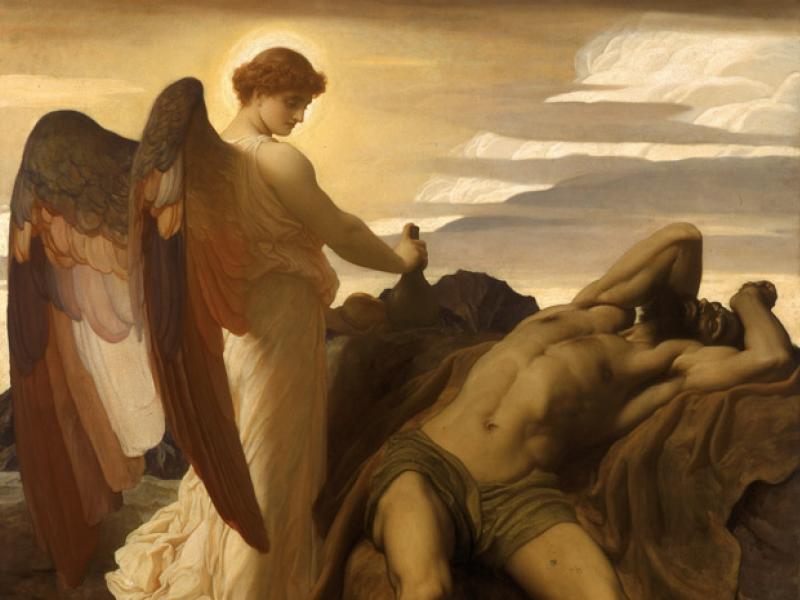
Gentle Spring

Painted by: Frederick Sandys
Dates back to: 1865
Where to see it: The Ashmolean Museum, Oxford, UK
The Mythology of Proserpina/Persephone being depicted:
Here we see Persephone (Queen of the Underworld/Goddess of Spring) in a floral and verdant garden as she returns back to the mortal realm to be with her Mother, Demeter (Goddess of the Harvest and Agriculture). Persephone is often thought to usher in the change of the Seasons, due to an agreement that was settled between Hades (King of the Underworld/God of the Dead) and Demeter by Zeus. When Persephone was stolen away by Hades to be his Wife in the Underworld, she ate some Pomegranate seeds that sealed her soul forever to the Underworld. However, her Mother was so distraught that she could not find her Daughter, and so she abandoned her duties and the mortal realm faded into a perpetual Winter and famine. Zeus could not let this continue, and so it was agreed that Persephone would spend half the year with Hades, and the other half of the year with Demeter. Therefore ushering in Autumn & Winter when Persephone departs to the Underworld, and ushering in Spring & Summer when she returns to her Mother.
Due to the fascinating duality of her nature, Persephone has the ability to conjure more than just flowers and vegetation. She has also been known to conjure the spirits of the dead through Necromancy and bestows a peaceful death to deserving souls on their way to the Underworld.

The Lament for Icarus

Painted by: Herbert James Draper
Dates back to: 1898
Where to see it: Tate Britain, London, UK (currently not on display)
The Mythology of Icarus being depicted:
The boy who flew too close to the Sun. Icarus and his father Daedalus, a masterful inventor/architect, were both mortals who were imprisoned by King Minos of Crete to keep secret that the monstrous Minotaur was hidden deep within the never-ending pathways of the Labyrinth, which Daedalus designed.
Using their wit and intelligence, they gathered feathers from the birds that rested atop the tower they were imprisoned within, and wax from the candles that lit their confines. Together they meticulously created a pair of human-sized wings so that they could escape into the skies where King Minos and his men would not be able to capture them again. However, as they soared through the skies to their freedom, Icarus became consumed with the power of flight, and thus went higher and higher despite his Father's warnings. And the closer Icarus flew to the sun, the faster the wax holding his wings together began to melt. Daedalus could do nothing but watch as his foolish Son plummeted back down to Earth, where we can see the Nymphs tending to his lifeless body in Draper's beautifully haunting painting.

Cupid and Psyche in the Nuptial Bower

Painted by: Hugh Douglas Hamilton
Dates back to: 1793
Where to see it: National Gallery of Ireland, Dublin, Ireland
The Mythology of Eros and Psyche being depicted:
The tale of Eros (the God of Love and Desire) and Psyche (a mortal Princess who became Goddess of the Soul and Beauty), is one of tender love, forbidden romance, and determination. And - quite rarely - this Greek Myth has a happy ending, as we can see in Hamilton's painted depiction.
Born with beauty that rivalled Aphrodite's, Psyche found herself trapped within a magnificent palace filled with all the luxuries she could ask for, and her sweet and loving captor would only visit her in the darkness of night to hide his identity. Her captor was Eros, and he was forced to hide his identity so that his jealous Mother would not find out that he had gone against her wishes. Aphrodite had ordered Eros to make Psyche fall in love with a hideous monster, as punishment for how the subjects of Psyche's kingdom only brought offerings to her and not Aphrodite, but Eros himself had fallen in love with Psyche and wanted to protect her.
One day Psyche was convinced by her sisters to take a glance at her captor, and in doing so, she discovered who he was and accidentally spilt candle wax on Eros. This woke him, and the betrayal of trust led him to abandon her.
To win Eros' love back, she went to Aphrodite to plead her case, and so Aphrodite gave her 3 challenges to make sure that she was worthy of being betrothed to her Son. Psyche was able to complete all of the 3 challenges, with some help from the Gods, and also while being heavily pregnant. But despite this, Aphrodite still refused to let Psyche be with her son. As the Gods were watching these events unfold, they sent Hermes to tell Eros of the trials that Psyche had gone through to be with him again, and so Eros went back to reunite with his love.
Zeus, on a technicality, agreed with Aphrodite that Psyche was not a perfect match to wed a God. And so, as an early wedding gift, Zeus permitted Psyche to sip some Ambrosia, the drink of the Gods, so that she was gifted with immortality and became a Goddess. As she was no longer mortal, she was now a perfect match for Eros and they lived together in love and happiness in Eros' palace. Even Aphrodite was happy with the fact that people were again worshipping her beauty, and not Psyche's. So happy endings all around!

Apollo Pursuing Daphne

Painted by: Giovanni Battista Tiepolo
Dates back to: 1744
Where to see it: National Gallery of Art, Washington, USA
The Mythology of Apollo and Daphne being depicted:
In this story, Eros does not show any kindness. This is because Apollo (God of Light, Music, and Prophecy) became boastful and arrogant that his archery skills were much better than Eros'. And so to teach him a lesson, Eros shot a golden arrow with a sharp glistening point at Apollo, and a blunt lead arrow at Daphne (a Nymph who was a hunting partner to Artemis (Goddess of the Hunt, Wild Nature, and Chastity/Apollo's twin sister)). Daphne was already sworn to chastity, but Eros' arrow ensured that she would be repulsed by the advances of Apollo who was now madly infatuated with her.
Unfortunately, this led Daphne to flee and Apollo chased after her in fear that she would fall or hurt herself. She ran to her father, Peneus (a river God), who can be seen in the lower left of Tiepolo's painting. As Apollo managed to reach Daphne and had her within his grasp, Peneus transformed his daughter into a Laurel tree - in the painting you can see her fingers sprouting into Laurel branches. Even though Daphne was now but a tree, his love for her did not waiver, and so Laurel became Apollo's sacred tree. Crowns of Laurel were awarded to winners of athletic, military, music, and poetry contests in Ancient Greece, and it is also said that the Oracle of Delphi (the High Priestess of the Temple of Apollo) would chew Laurel leaves before receiving his wisdom.

The Fury of Achilles

Painted by: Charles-Antoine Coypel
Dates back to: 1737
Where to see it: The State Hermitage Museum. Saint Petersburg, Russia
The Mythology of Achilles being depicted:
This bloodthirsty painting set in the midst of the Trojan war features Athena and Poseidon (God of the Sea, Earthquakes, and Horses) beside Achilles (a Demi-God) as he charges towards his sworn enemies Scamander (a river God) and his brother Simoeis (another river God). In the sky, you can also see Hera, usually depicted with a Peacock, who is ushering torch-bearing Hephaestus (God of the Forge and Fire) to his aid.

The Torture of Prometheus

Painted by: Salvator Rosa
Dates back to: 1648
Where to see it: Galleria Corsini, Rome, Italy
The Mythology of Prometheus being depicted:
Prometheus (a Titan/God of Forethought) stole fire from Mount Olympus and gifted it to the mortal realm, as he was the one who moulded the first human beings out of clay and could not bear to watch his greatest creations suffer under their dependence on the Greek Gods. Zeus was furious with him and as punishment, he chained Prometheus to a rock on Mount Kaukasos and has an Eagle peck out and eat his Liver. At night, his Liver would grow back, and the torture would repeat once again. Over, and over, until the end of time.
Luckily Hercules put an end to Prometheus' never-ending torture by killing the Eagle and breaking the chains that shackled him. Eventually, Prometheus was also able to make amends with Zeus.

Landscape with Charon Crossing the Styx

Painted by: Joachim Patinir
Dates back to: 1524
Where to see it: Museo del Prado, Madrid, Spain
The Mythology of Charon being depicted:
Toss a coin to Charon! And you will be permitted safe passage across the famed River Styx and Acheron within Hades' and Persephone's realm of the Underworld. Charon (an Underworld deity) was the Son of Nyx (a primordial Goddess/the personification of Night) and Erebus (a primordial God/the personification of Darkness). His role was to be the ferryman of the Underworld, transporting the newly deceased souls to be judged by Hades. Obolus or Danake coins were often left in the mouths of the deceased, as a fee for the ferryman.
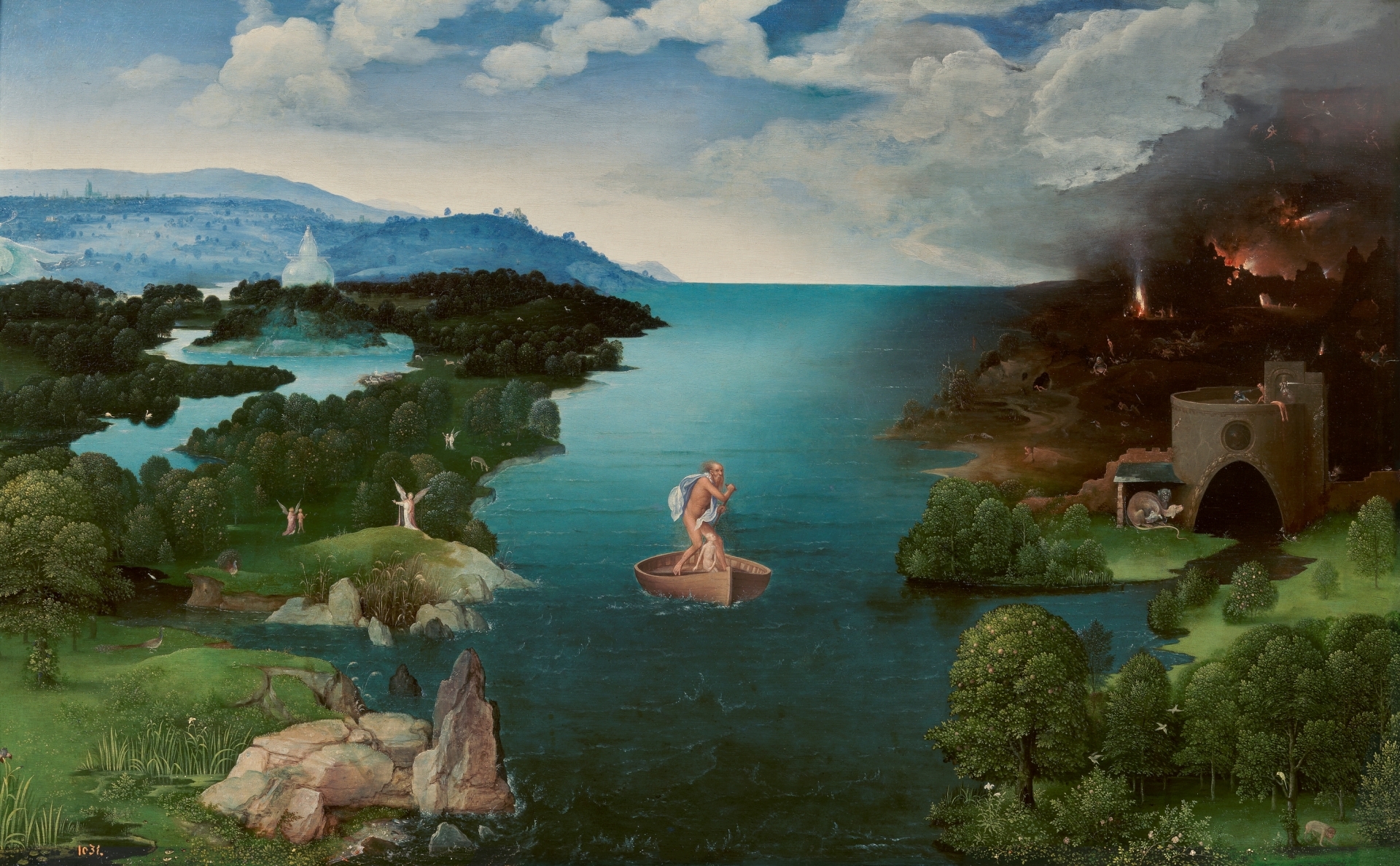
The Sirens and Ulysses

Painted by: William Etty
Dates back to: 1837
Where to see it: Manchester Art Gallery, UK
The Mythology of Ulysses/Odysseus being depicted:
Within this painting brought to life by William Etty, you can see Odysseus (a legendary Greek hero in Homer's "Odyssey"/King of Ithaca/also known as Ulysses in Latin) bound to his ship by his men as he struggles to avoid the temptation of the Sirens' entrancing yet deadly melodies. The Sirens were half-bird half-female Monsters that were known to drown Sailors by luring them in with their irresistibly sweet musical voices. And at the advice of Circe (a Sorceress and minor Goddess/Daughter of Helios (a Titan/God of the Sun)), Odysseus' men plugged their ears with beeswax, but Odysseus was curious to hear what the call of a Siren sounded like, as he returned back home to Ithaca from battling in the Trojan War.

Eva Prima Pandora

Painted by: Jean Cousin
Dates back to: 1550
Where to see it: Musée du Louvre, Paris, France
The Mythology of Pandora being depicted:
While Prometheus made the first mortal man out of clay, Hephaestus (at the request of Zeus) made the first mortal woman. Her name was Pandora, and she was bestowed with the breath of life by Zeus, clothed by Athena, blessed with beauty by Aphrodite, the ability to speak and lie by Hermes, curiosity by Hera, and plenty of other gifts from other Greek Gods and Goddesses.
Pandora was wedded to Epimetheus (Titan/God of Afterthought/Brother to Prometheus, Atlas, and Menoetius). And she was given a gift from Zeus on her wedding day.
If you remember back to Prometheus, then you would remember that Zeus wasn't very happy to learn that humankind now possessed the gift of fire. So in his gift to Pandora, he bestowed the evils he wished to unleash upon mankind so that mortals would remain as lesser beings to the Gods.
With Zeus' gift now in her possession, she was told not to open it under any circumstances. But the deliciously tempting whispers that came out of the box, as well as the curiosity that Hera had bestowed upon her, caused Pandora to take a peek. As she lifted the lid off the box, she unleashed a myriad of evil and misery onto the world, thus ending the Golden Age of humankind. Hate, illness, envy, hunger, strife, pain, poverty, and more, with the last one being Hope.
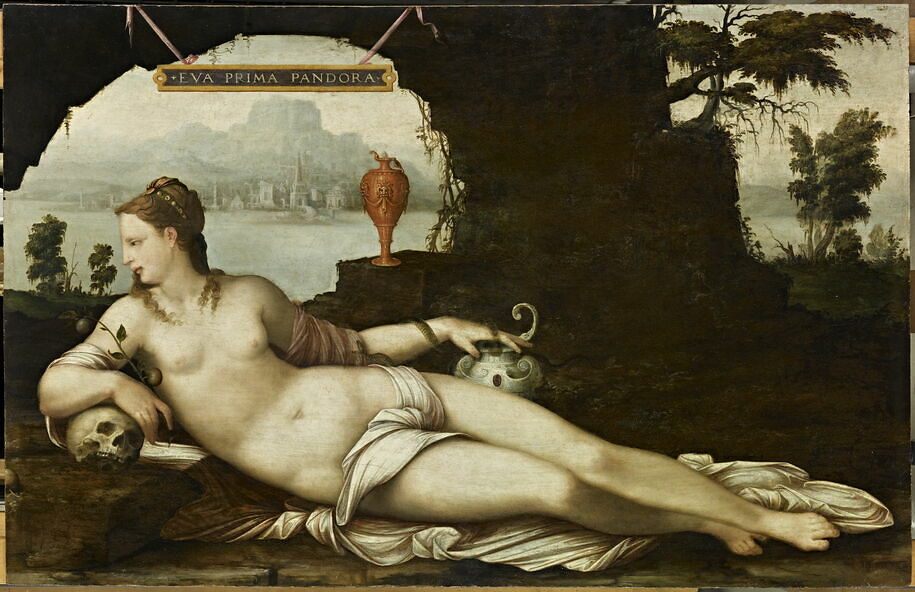
Perseus and Andromeda

Painted by: Frederic Leighton
Dates back to: 1891
Where to see it: The Walker Art Gallery, Liverpool, UK
The Mythology of Perseus and Andromeda being depicted:
This absolutely breathtaking mythical painting by Frederic Leighton depicts the rescue of Princess Andromeda who is being offered by her father, King Cepheus of Aetheopia, as a sacrifice to Poseidon. This was because Queen Cassiopeia made the mistake of boasting that Princess Andromeda was more beautiful than the Nereids (Sea Nymphs). And in retaliation, Poseidon had unleashed a beastly Sea Monster named Cetus upon their kingdom.
In the glare of golden sunlight, you can see Perseus flying in on Pegasus (born from the blood of Medusa's decapitated head) to slay Poseidon's Monster. He had fallen in love with the beauty of Andromeda, and after saving her from her doomed fate, he went on to ask for her hand in marriage which she accepted.


On Maddie's Mythical Tales, you can discover enchanting places to travel, fantasy news and updates, and tips to bring magic to your everyday life!
You can stay up-to-date on Instagram, X (Twitter) and on Pinterest.
And Sign Up to be notified when a new blog post gets released by clicking the red 'Subscribe' button.
Currently residing in West Sussex, Maddie is a 26 y/o blogger and illustrator with a passion for mythology, legends, fairytales & folklore. You'll regularly find her escaping into fantasy books, films, TV, and games.













Comments ()